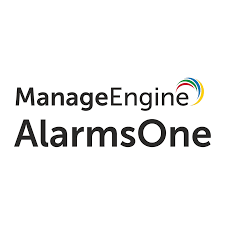Product Overview
ManageEngine AlarmsOne is a cloud based alarm management system that allows to view and centrally manage all application alarms; generate complete actionable report for each application alarm that it collects and finally, display them in a single console. AlarmsOne offer easy integration with many third-party applications, from which it collects alarms in real-time and then notifies users in real-time via multiple channels. It generates intelligent reports that categorize various alarms based on criteria like severity and status.
AlarmsOne Integrations:
- AlarmsOne supports in-bound integration with more than 25 monitoring tools and out-bound integration with a handful of team collaboration, incident management, and help desk tools. Integrate third-party applications with AlarmsOne to make your alarm management easy.
- Integrate AlarmsOne with on-premise monitoring tools like Nagios, Solarwinds, and AppDynamics using our REST API and with SaaS-based tools such as Site24x7, New Relic, and Server Density using our webhook API. Automate the inflow of alarms in your dashboard.
- Export your alarms by integrating AlarmsOne with team collaboration tools like Slack, HipChat, and Flowdock and help desk tools such as ManageEngine ServiceDesk Plus and Zendesk. Make your workflow more efficient.
- Integrate your internal monitoring tool or any custom application with AlarmsOne using our Email API. Experience AlarmsOne as a one-stop solution for alarm management.
- Integrate your in-house apps with AlarmsOne using our RESTful API. Manage alarms from all your IT management tools in one place.
Advantages of AlarmsOne
-Real-time alerts and multi-channel notifications.
-IT alert management made simple & effective.
-Multiple monitoring tools, one alarm engine.
-Manage multiple locations from one place.
-Intelligent classification and easy filtering.
-Simple alert management for complex IT
Specifications
Role-based access
Define alert criteria.
Create a rule to filter alerts based on different fields like display name, severity, message, or alert content. Trigger an action when a rule is satisfied.
Design your action.
Write scripts to clear memory space, delete log files, or perform another action when alerts are triggered. Run multiple scripts in an instant and perform various actions at the same time.
Execute actions as needed.
Choose the maximum number of times you need the scripts to be executed in a given amount of time. Send an email report about the auto-remediation action to on-call technicians.
Alarm actions
Respond to alerts promptly.
Update the status of an alert to let other users know it has been taken care of, or manually change an alert's severity to update its priority level. Filter alerts based on their status to see how many issues have been fixed and how many more need to be addressed. You can also search for alerts to make sure they don't fall through the cracks.
Share alerts.
If an alert needs special attention, you can share it with your Slack team to discuss and resolve it. You can also create a support ticket in your help desk tool, or submit the alert as a bug in your project management tool.
Collaborate on demand.
Notify an IT expert when you need a hand with a troublesome issue. Attach comments to alerts to explain the issue and send notifications through any or all alert channels. Help really is just a click away.
Acknowledge via phone.
You don't need to log in to your account to acknowledge an alert. All you need to do is press "2" when AlarmsOne notifies you through a phone call.
Alarm grouping
Eliminate redundancy.
Administrators often receive repeated alerts about the status of a website, server, or any other entity. By grouping your alerts in AlarmsOne based on display name or entity name, you can view the latest alert alone, and neglect any previous alerts that are redundant.
Focus on what matters.
Group your alerts according to severity and classify them as critical, major, warning, or info. Critical alarms have the highest priority and should be addressed first to maximize uptime. This classification process helps notify specified contacts and assign tasks according to need.
Track event history.
Aggregate your alerts based on application, category, or entity to track alert history and find the root cause of incidents and resolve them faster.
Act on alert groups.
Select an alert group and acknowledge, close, or delete multiple alerts at once. You can also change the severity of a group if that group of alerts requires attention.
Custom views
Define rules to filter alerts.
Create a custom view, then define your own configuration profile to filter out specific alerts in that view. You can also associate applications with a configuration profile to create a new view.
Create multiple views.
Create as many views as you need, so you can easily categorize your alerts and act on them quickly.
View all your alerts.
You can also view alerts from all your applications in the "All Alarms" view.
Generate alarm reports.
Generate a report for all the alerts in any view so you can drill down into data that's important to you.
Alarm tags
Tag AlarmsOne agents.
Identify alerts from a particular agent using tags. Once you've tagged an agent, you can pinpoint alerts from a particular location where your IT infrastructure is installed.
Tag your notification profiles.
Easily identify alerts that satisfy a particular notification profile or escalation policy.
Tag your applications.
Tagging applications helps you quickly spot alerts from those applications. For instance, you can create a website monitoring tag just for alerts from your website monitoring applications.
Tag alerts manually.
If you ever need to flag an alert, you can manually tag that alert by opening it in the Alarms page.
Multi-criteria alerting
Increase alert accuracy.
Don't waste time on alerts that you don't need to act on. Run multiple conditions at the same time to improve alert accuracy and get notified only for those incidents that require your attention.
Configure in-depth notifications.
Filter your alerts based on different fields like display name, severity, message, or alert content, and receive notifications that are rich in data. Enter custom field values while defining the notification criteria to create notifications based on your requirements.
Generate intuitive alerts.
Easily set complex rules to automatically raise support tickets in ServiceDesk Plus, or submit bugs to your project management tool. Consolidate your alerts and share only those alerts that need to be discussed with your Slack team.
Customize your notification profile.
Add applications to a notification profile so users are notified when alerts from those applications satisfy specific rules. Manage the alert flow by associating applications with notification criteria and users.
Noise reduction
Get rid of redundant alerts.
Your monitoring tool sends alerts every time it polls your system. If the polling frequency is high, your monitoring tool might send you too many alerts about the same incident in a short time span. Using AlarmsOne's noise reduction feature, you can choose to get notified once and eliminate the other redundant alerts.
Select a time-out period.
A time-out period tells AlarmsOne how long it has to wait before notifying you again about the same incident. If the time-out period is five minutes, then AlarmsOne will notify you about an incident once and wait five minutes before notifying you again (assuming the event is still unresolved).
Alarm modifier
Match real severity levels.
Automatically change the severity of incoming alerts in AlarmsOne to critical, major, warning, or info based on the alarm content. Prioritize alarms based on the actual severity of the incident, not just the irrelevant severity level assigned by some monitoring tools.
Respond to alerts automatically.
Automatically change the status of incoming alerts to "acknowledged" or "closed" when they satisfy certain defined conditions.
Delete unwanted alerts.
Stop unnecessary alerts from showing up on your Alarms page by automatically deleting alerts that meet certain rules.
Schedules
Choose your on-call technician.
Configure schedules to avoid confusion over who acts on which alerts and for how long. You can even add multiple shifts with custom timings and any number of users. See who is on call with the calendar view.
Rotate your shifts.
Configure schedules exactly as you need them with daily, weekly, monthly, or custom shift rotations. Rotate shifts by the day of the week and time of day.
Define a time period during which a particular schedule should be active. This comes in handy if you have a different schedule for the next quarter. If you don't define the time period for a schedule, the schedule will continue until you stop it manually.
Exclude non-working days.
If your business is closed on particular days of the week, you can choose to exclude those days from a schedule. That way, AlarmsOne won't send alert notifications on those days.
Overrides
Never miss an alarm.
Substitute one user for another, delegate responsibilities, and never let an alert go unnoticed. Choose how long a shift should be overridden. You can also view the active, upcoming, and completed overrides in the overrides window.
Share the workload equally.
More than one user can override another user's shift, and AlarmsOne will split the work time equally among those users.
Exclude schedules.
If a user is part of two active schedules with overlapping shifts, you can choose to exclude one of the schedules and not override that shift.
Alarm escalations
Define a notification sequence.
Create escalation policies to decide who receives an alert first, the escalation time-out duration (how long the first recipient has to respond before the alert is sent to the next recipient), and whom to notify next.
Never fail to act on critical alerts.
Escalate alerts and pass them on to contacts, schedules, or outbound apps like Slack, ServiceDesk Plus, or Trello so that available technicians can respond to critical alerts and resolve them before it's too late.
Notify the next on-call person.
Notify the on-call person in an active shift, the on-call person in the next shift, or both to make sure no alert is missed at the end of a shift.
Repeat notifications until alerts are acknowledged.
You can add up to five levels of escalation to ensure a critical event never goes unnoticed.
Real-time collaboration
Say no to miscommunication.
Thanks to outbound integrations, you can automatically share your alerts with team collaboration tools such as Slack, Hipchat, and FlowDock. Consolidate all your discussions and decisions in one place to eliminate miscommunication.
Create tickets from alerts.
You can share your alarms with major help desk tools such as ServiceDesk Plus and Zendesk. Automatically log a ticket when an alarm is raised to enhance your workflow automation and service management.
Submit alerts as bugs.
Integrate AlarmsOne with project management tools like Atlassian Cloud, Zoho Projects, and Trello so you can submit an alert as a bug and track the follow-up actions to resolve an event.
Downtime
Eliminate redundant alerts.
Schedule your downtime in AlarmsOne to stop receiving meaningless alerts when your IT is under maintenance. During scheduled downtime, AlarmsOne will continue to receive alarms but will not send out any notifications.
Configure application-based downtime.
You can add downtime to an application, website, server, printer, or other entity. Suspend alerts when you fix a faulty application or reinstate an entity. You can also choose to schedule downtime for all your entities at the same time.
Configure location-based downtime.
Carry out maintenance operations specific to a location that uses a particular AlarmsOne agent. Select the time zone of the location where the agent is deployed and select the time period for the downtime. This mutes notifications from every entity that uses that particular agent.
Save alert credits.
Configure downtime and mute unwanted notifications to save alert credits so you can use them at another time.
Alarm tracking
Know the who and when.
AlarmsOne provides complete details about every alert, including when the alert was triggered and who was notified. You can even check whether an alert was shared with your Slack team or raised as a ticket in your help desk tool. You can also view the comments about an alert.
Track alert actions.
Look into recent activities to easily find which escalation policy an alert satisfied, when your on-call technician responded to the alert, the current status of the alert, and much more.
Enjoy transparency.
View key AlarmsOne performance details, including uptime and incident stats, on our status page. You can always check our service availability and other performance metrics by visiting https://status.manageengine.com/.
On-the-go alert management
Get instant push notifications.
Receive push notifications on your iOS and Android mobile devices each time a new alert is triggered in AlarmsOne. View event details by opening the alert notification.
Respond to alerts.
Use the AlarmsOne mobile app to act on open alerts. Easily acknowledge, close, share, or delete alerts while you're on the move.
Manage on-call schedules.
Using our mobile app you can define schedules, shift overrides, notification profiles, and escalation policies to choose your on-call technicians. You can also add new applications and schedule downtime through the AlarmsOne mobile app, making IT alert management easy, even when you're out of the office.







